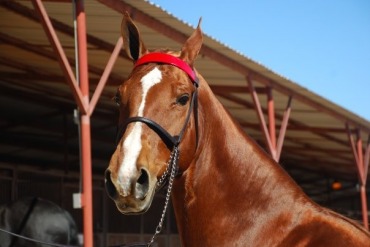1. Horses and ponies are measured in hands. A hand is the length of an average adult's palm, or 4 inches. The height is written as a number followed by the letters hh'. A horse stands at 14.2hh or above, whilst a pony is anything that measures under 14.2hh.
2. Horses and ponies can live up to 30 years old, we can tell how old a horse is by looking at their teeth. There are different stages of a horse's age.
*Any horse or pony under the age of 6 months old is known as a foal'.
*A horse aged between 6 months and 2 years old is called a yearling'.
*A filly' is a female horse or pony aged under 4 years old, whilst a male horse under 4 years old is called a colt'.
*'Mares' are female horses over the age of 4 years old.
*'Stallions' are male horses over the age of 4 years old.
*Sometimes stallions have an operation called castration' performed. This stops them from being able to breed. When they have been castrated, a male horse is called a gelding'.
3. There are lots of different breeds and colour of horse and pony. Some examples of the different breeds, their heights and colours are:
*Exmoor Up to 12.3hh Bay, brown or dun
*Connemara Pony 13hh 14.2hh Grey, black, brown or dun
*Shetland Pony 40 inches Various but usually black
*Icelandic Pony 13.2hh Various
*Arab 14hh - 15hh Bay, brown, black, chestnut and grey
*Thoroughbred 14.2hh 17.2hh Solid colours
*Shire 17hh 18hh Black, brown, bay or grey
4. A gait' is how we describe how fast a horse is going. There are four different gaits:
*Walk is the slowest pace
*Trot is when the horse is jogging slowly
*Canter is when the horse is running
*Galloping is the fastest a horse can go, sometimes up to 50 miles per hour!
5. Horses can sleep standing up. This is so that in the wild, if they were woken up by a predator they would be able to get away quicker. You might sometimes see one horse asleep in the field whilst the others are eating. This is because that horse guards' the herd during the night, so sleeps during the day and eats at night.
6. A group of horses is known as a herd'. In the wild, one stallion will have about 20 mares in his herd. The oldest mare is called the alpha mare', meaning that she is in charge and leads the herd to new grass and away from danger.
7. Horses have lots of different noises that they make.
*Neighing or Whinnying is a greeting call. It is often heard from mares when she is separated from her foal.
*Whickering is a noise made when giving care e.g. between mare and foal or horse and owner at feeding time.
*Snorting is an alarm call used to warn the rest of the herd of danger.
*Roaring is a mating call from the stallion directed to the mare.
*Squealing is a subordinate call. It is generally heard between two new horses meeting. They go nostril to nostril before squealing and sometimes striking out with their front hooves.
8. Horses eyes are on the side of their head, which means that they can see all around them. There ears also move so that they can listen to noises that are coming from different angles. They also have a better sense of smell than humans.
9. Horses have the Latin name of Equus caballus'. They are members of the Equidae' family. Other equus species are:
*Zebra
*Donkey
*Onagers
10. Domestic horses are generally fairly good with other animals. They are often partnered with donkeys, sheep and cows for companion. Behavior goes hand in hand with past experiences. If a horse has been mistreated it will be wary of other animals. They can be good with dogs as long as the dog is well trained and behaves.
A Horse's Tail
A horse's tail is very important to him. Not only does it act as a fly swatter in summer, it keeps his "bottom" warm in winter! The area between a horse's hind legs is the only part not kept warm by hair, so it loses the greatest amount of warmth if left exposed by too much trimming.
From a horse's point of view, the best tail is a natural tail.
Some horses have thin ragged tails, while others have tails so thick they cannot be braided for formal riding events and shows. To make the best of their appearance, thick or thin, different tails are treated in different ways. Some styles even go in and out of fashion!
A horse's tail is very important to him. Not only does it act as a fly swatter in summer, it keeps his "bottom" warm in winter! The area between a horse's hind legs is the only part not kept warm by hair, so it loses the greatest amount of warmth if left exposed by too much trimming.
From a horse's point of view, the best tail is a natural tail.
Some horses have thin ragged tails, while others have tails so thick they cannot be braided for formal riding events and shows. To make the best of their appearance, thick or thin, different tails are treated in different ways. Some styles even go in and out of fashion!

